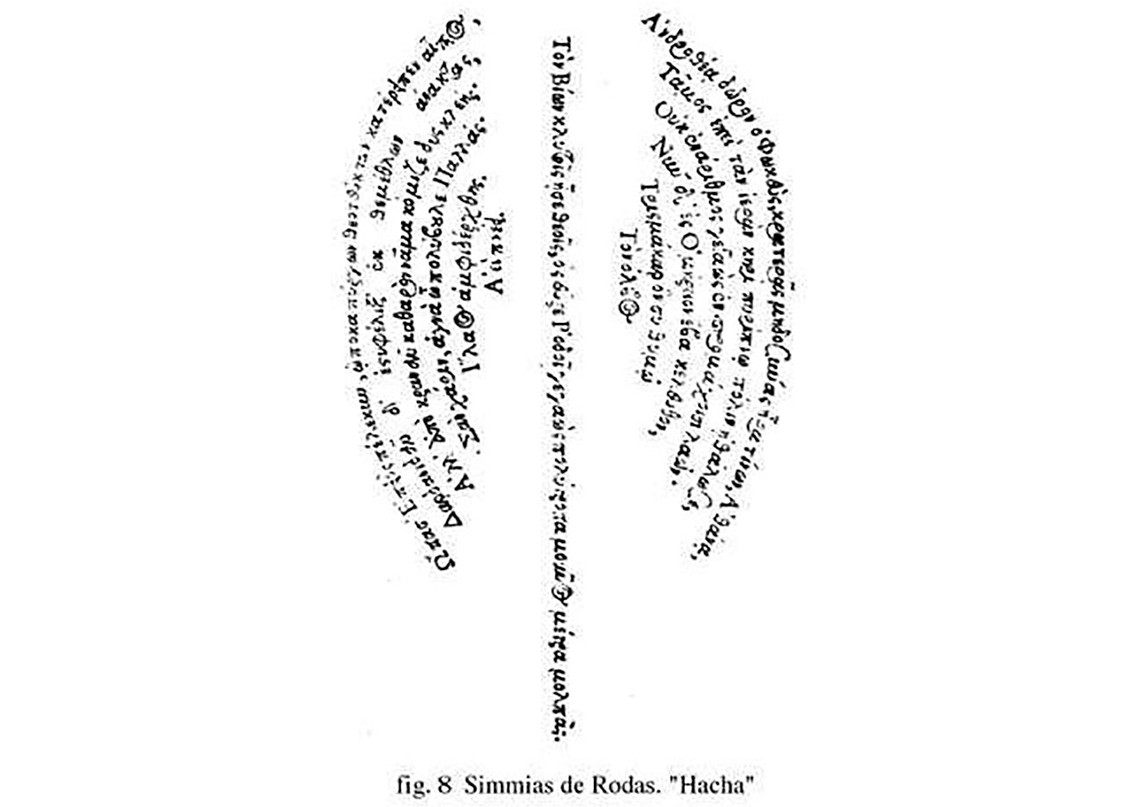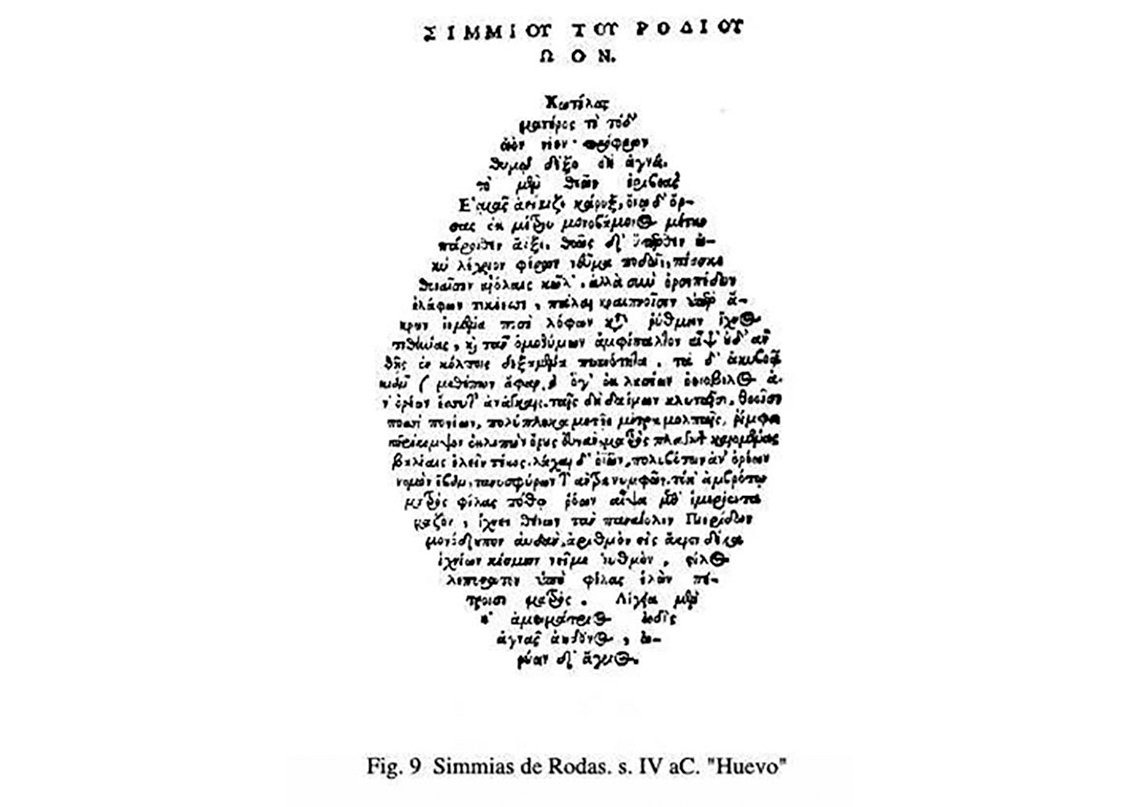Minds On
Imagine words with objects
Student Success
Think-Pair-Share
Imagine words on an object. Concrete poems that were started over 2,000 years ago in Greek Alexandria, a time in Ancient Greece. The first three images were written around early 300 BCE by Ancient Greek poet and scholar Simmias de Rhodes. Concrete poems were poems that were often written on an actual object or into an image, except the poetry never directly described or mentioned the object. Many cultures and years later, poems continue to be inspired by concrete poems. In 1633, Englishman George Herbert wrote the poem in the 4th image. Guess the name of each of these poems.
Note to teachers: See your teacher guide for collaboration tools, ideas and suggestions.
The names of the first three poems are originally written in Greek. The translated names of the poems in order of appearance are: “hatch,” “egg,” “wings.” The fourth poem written in English of the 1600s is called “Easter Wings.” Explore and find a synonym using a thesaurus for “hatch.”
In this learning activity, you will be writing a shape poem inspired by the concrete poems of Ancient Greece.
Action
The shape poem
A shape poem can rhyme, but it doesn't have to. Use the appropriate success criteria explained by your teacher as they will indicate if you are required to use rhyme.
Writing a shape poem
1. Choose a topic
The shape of the poem is usually about or connected to the topic of the poem. The words in the poem will create the image of your poem.
Choose a topic about making a positive change in the world that you are passionate about. Possible topics include: rescuing animals, fostering animals, helping food banks, volunteering, protecting wildlife or the natural environment, or other topics suggested to you by your family members or an adult. Brainstorm (mind-map) or peruse visual images or photos for possible ideas and topics to choose from.
2. Choose a shape
Choose a shape connected to your topic. Lightly sketch out the outline of the shape of the poem. This is where the words of your poem will go!
3. Preparing to write your poem
Write your poem on the outline of your shape.
Follow the success criteria. Include adjectives such as comparative adjectives, adverbs, idioms, irony, alliteration. You may use a graphic organizer and mind map and/or brainstorm to help generate descriptive words to help create a mood using alliteration. Use a thesaurus or dictionary of idioms.
Mini-Module
What is alliteration?
Alliteration is when you choose words with a repeating letter sound such as "smooth slithering slippery snakes stake such satisfying synonyms to spell."
Student Success
Think-Pair-Share
Try to grow the following phrases with alliteration:
- ‘farm frog freddie’
- ‘marching men’
- ‘rapidly rowers’
- ‘singing swallows’
- ‘crystal clear’
The letters shared by each word that is part of the alliteration are the same and produce the same sound.
If possible, give a partner a phrase with a couple of words to grow using alliteration. While you’re writing your poem, think-pair-share with a partner, if possible, to help each other come up with words to add using alliteration in each other’s poems.
Note to teachers: See your teacher guide for collaboration tools, ideas and suggestions.
Adjectives
What are adjectives?
First, let’s review adjectives. You’ll notice how adjectives qualify something, that something is a noun.
Explore the following two Homework Zone videos to review your knowledge of adjectives.
Comparative adjectives
Add an ‘-er’ or ‘-est’
We take certain adjectives and add endings like -er to turn the word fast into faster or fastest. In these cases, the er and est ending characterizes the comparative adjective. With some words we have to drop their y endings and add -ier or -iest. For example, cuddly becomes cuddlier or cuddliest.
We can also include using the comparative word “than.”
The rabbit is faster than the turtle.
Drop the ‘y’ and replace with ‘-ier’ or ‘-iest’
In the following cases, you would drop the ‘y’ and replace it with an ‘-ier’ or ‘-iest’ ending
Weather conditions:
Windy, stormy, rainy, cloudy, foggy, snowy, chilly
Cleanliness:
Smelly, dirty, messy, tidy
Size:
Tiny
Surface textures:
Shiny
Feelings:
Happy, angry, crazy, witty, cuddly, silly
Descriptors of food flavour:
Spicy, salty, sugary, savoury
When words like ‘or’ are used to compare adjectives
Some adjectives don’t follow the ‘-y,’ ‘-er,’ or ‘-est’ rule and require qualifier words like ‘or.’
Weather conditions:
Humid or dry
Size:
Small or big or large or medium
Thick or thin
Short or tall
Wide or narrow
Speed:
Fast or quick or slow
Surface textures:
Sharp or dull or brittle
Personality:
Mean or kind
Responsible or irresponsible
Descriptors of food flavour:
Bland or flavourful or sour
Colour:
Red, orange, yellow, green, blue, violet, brown, black, white … magenta!
When words don’t follow either rule…
In some cases, words don’t follow either of the rules that you’ve examined so far.
For example, the adjective “good” doesn’t get turned into “gooder” or “more good.” Instead, we use the word “better.” Same with “bad,” which doesn’t get turned into “badder” or “more bad.” Instead, we use the word “worse.”
The following example are some words that don’t follow the rules explained:
good, bad, joy, excitement, excite, depressed, anxious, bored, articulate, concise,
ridiculous, generous, delicious, sour, attentive, patient, impatient, unusual, sour,
responsible/irresponsible, dedicated, motivated
How do we know which words follow which rules? We familiarize ourselves simply by reading good writing, and often.
Comparative adjectives word work exercise
Student Success
Think-Pair-Share
Practice changing the following sentences to include a comparative adjective to grow the sentence to give more description and detail.
- The student ran fast.
- The neighbour gave out party bags for halloween.
- The sibling saved the last cookie for their sister.
- The dog sat wagging its tail.
Note to teachers: See your teacher guide for collaboration tools, ideas and suggestions.
Review adverbs
Now, we’ll take some time to review adverbs.
Examine the following two Homework Zone videos to better understand adverbs, as well as understanding the difference between adverbs and adjectives.
Student Success
Think-Pair-Share
Make up 5 to 10 simple basic sentences to change into a new sentence to include adjectives and/or adverbs.
Note to teachers: See your teacher guide for collaboration tools, ideas and suggestions.
4. Give your poem a title
Be sure to give your poem a title.
5. Revise your poem
Edit for correct use of punctuation and spelling. Be sure to use appropriate resources or a partner, if possible, to help you.
6. Write a final draft
Think about which fonts and/or font sizes to include for your published poem.
7. Publish your poem
Create the final outline of your shape using very light pencil tracing to outline the shape. Write the revised poem on your outline using print and/or cursive, colour and/or appropriate fonts and font sizes.
Consolidation
Present and share your shape poem!

Present your poem in a poetry reading and/or display of your choice. If possible, invite an audience/readers to express their thoughts and feelings in response to your poem.
Reflection
As you read through these descriptions, which sentence best describes how you are feeling about your understanding of this learning activity? Press the button that is beside this sentence.
I feel…
Now, record your ideas using a voice recorder, speech-to-text, or writing tool.
Discover more
Press ‘Discover More’ to extend your skills.
Discover MoreMake a paper mâché object of your poem. Write your poem on your paper mâché object after it dries. Share your work in a display.



